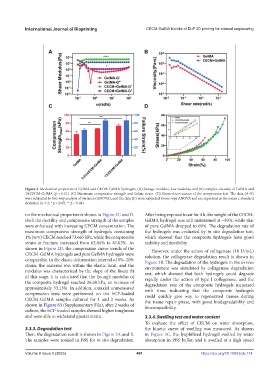Page 489 - IJB-9-5
P. 489
International Journal of Bioprinting CECM-GelMA bioinks of DLP 3D printing for corneal engineering
Figure 2. Mechanical properties of GelMA and CECM-GelMA hydrogels. (A) Storage modulus, loss modulus, and (B) complex viscosity of GelMA and
1%CECM-GelMA (p < 0.01). (C) Maximum compressive strength and failure strain. (D) Stress‒strain curves of the compression test. The data (A–B)
were subjected to two-way analysis of variance (ANOVA), and the data (C) were subjected to one-way ANOVA and are expressed as the mean ± standard
deviation (n = 3; * p < 0.05, ** p < 0.01).
on the mechanical properties is shown in Figure 2C and D. After being exposed to air for 4 h, the weight of the CECM-
Both the ductility and compressive strength of the samples GelMA hydrogel was still maintained at ~83%, while that
were enhanced with increasing CECM concentration. The of pure GelMA dropped to 69%. The degradation rate of
maximum compressive strength of hydrogels containing the hydrogels was evaluated by in situ degradation test,
1% (w/v) CECM reached 73.665 kPa, while the compressive which showed that the composite hydrogels have good
strain at fracture increased from 62.84% to 87.02%. As stability and durability.
shown in Figure 2D, the compression curve trends of the However, under the action of collagenase (10 U/mL)
CECM-GelMA hydrogels and pure GelMA hydrogels were solution, the collagenase degradation result is shown in
comparable. In the elastic deformation interval of 0%–20% Figure 3B. The degradation of the hydrogels in the in vivo
strain, the material was within the elastic limit, and the environment was simulated by collagenase degradation
modulus was characterized by the slope of the linear fit test, which showed that both hydrogels could degrade
of this stage. It is calculated that the Young’s modulus of rapidly under the action of type I collagenase, and the
the composite hydrogel reached 26.68 kPa, an increase of degradation rate of the composite hydrogels increased
approximately 33.13%. In addition, uniaxial unmeasured with time, indicating that the composite hydrogels
compression tests were performed on the hCF-loaded could quickly give way to regenerated tissues during
CECM-GelMA samples cultured for 1 and 2 weeks. As the tissue repair phase, with good biodegradability and
shown in Figure S3 (Supplementary File), after 2 weeks of biocompatibility.
culture, the hCF-loaded samples showed higher toughness
and were able to withstand greater strain. 3.3.4. Swelling test and water content
To evaluate the effect of CECM on water absorption,
3.3.3. Degradation test the kinetic curve of swelling was measured. As shown
Then, the degradation result is shown in Figure 3A and B. in Figure 3C, the lyophilized hydrogel swelled by water
The samples were soaked in PBS for in situ degradation. absorption in PBS buffer, and it swelled at a high speed
Volume 9 Issue 5 (2023) 481 https://doi.org/10.18063/ijb.774

